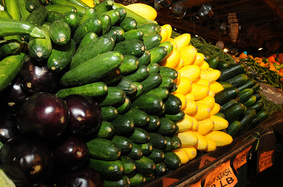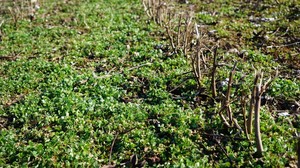|
Having trouble viewing this email? View it as a Web page.

|
|
|
Fresh from the Field is a weekly album showcasing transformative impacts made by grantees supported by the National Institute of Food and Agriculture.
Editor: Falita Liles Feb.8, 2018
|
|
Success Stories

Removing Nitrate for Healthier Ecosystems
Nitrogen can present a
dilemma for farmers and land managers. On one hand, it is an essential nutrient
for crops. On the other, excess nitrogen in fertilizers can enter groundwater
and pollute aquatic systems. This nitrogen, usually in the form of nitrate, can
cause algal blooms. Microbes that decompose these algae can ultimately remove
oxygen from water bodies, causing dead zones and fish kills.
In a new study, University
of North Carolina (UNC) researchers identified nitrate removal hotspots in
landscapes around agricultural streams. “Understanding where nitrate removal is
highest can inform management of agricultural streams,” said Molly Welsh, lead
author of the study. “This information can help us improve water quality more
effectively.”
NIFA supports this
research through the Agriculture and Food Research Initiative.
Read the full story at the Soil Science Society of America. Photo credit Jordan Gross and Philippe Vidon.
|
News Coverage

Sequencing the Potato Beetle Album Genome
The Colorado potato beetle
is notorious for its role in starting the pesticide industry and for its
ability to resist the insecticides developed to stop it. Managing the
beetle costs tens of millions of dollars every year, but this is a welcome alternative
to the billions of dollars in damage it could cause if left unchecked.
To better understand this
tenacious pest, a team of scientists led by University of Wisconsin-Madison entomologist Sean Schoville sequenced
the beetle’s genome, probing its genes for clues to its surprising adaptability
to new environments and insecticides. The new information sheds light on how
this insect jumps to new plant hosts and handles toxins, and it will help
researchers explore more ways to control the beetle.
NIFA supports this
research through Hatch Act funding.
Read the full article at UW Madison CAL News. Photo credit UW Madison.
|
The Library

Studying a Mass Media Health Campaign's Reach
and Effect on Obesity
The combined overweight
and obesity prevalence in American Samoa currently stands at roughly 94
percent, making American Samoa the most overweight and obese country in the
world. That obesity rate is directly associate with the high prevalence of type
2 diabetes, cardiovascular disease, and other chronic diseases. Health
educators from American Samoa Community College partnered with TVZK, the
local public television station, to broadcast the HBO series The Weight of
the Nation, in the first widespread, continual health communications and
social marketing campaign to combat the problem locally. All viewers who
responded to a survey reported increasing fruit and vegetable consumption and
physical activity and about 47 percent of residents reported growing the highly
nutritious, edible laupele in home vegetable gardens.
NIFA supports this research through Hatch Act funding.
Read the article at the National Conference on Health Care
Communication, Marketing, and Media. USDA
photo by Alice Welch.
|
Video
 No-Till Cotton in Tennessee
Cotton, a major crop grown
in the Southeast, leaves very little residual biomass after harvest. Without a
crop covering the ground, soil exposure can lead to erosion from winter rains
and runoff. To remedy this situation, producers have steadily adopted no-till
agriculture as a way to save topsoil and reduce soil erosion in their fields.
Chris Boyer and other
researchers from the University of Tennessee (UT looked at the data from the
past 29 years to determine whether including cover crops in an erosion
management strategy is profitable. They found that while cover crops can cut
into profitability over the short term, there are a number of benefits over
long-term adoption. "The benefits are accumulated and it takes a number of
years before you see them," said Boyer.
The study found that
conventional tillage practices result in higher profits than no-till practices;
however, continuous no-till planting reduces risk exposure by decreasing yield
variability.
NIFA supports this project with Hatch Act funding.
Watch the video from UT. Photo credit G. Rowsey/UT.
|
Tweet of the Week
#NIFAIMPACTS

|
|

NIFA’s mission is to invest in and advance agricultural research, education, and extension that solve societal challenges. NIFA’s investments in transformative science directly support the long-term prosperity and global preeminence of U.S. agriculture. To learn more about NIFA’s impact on agricultural sciences, visit www.nifa.usda.gov/Impacts, sign up for email updates or follow us on Twitter @USDA_NIFA, #NIFAImpacts.
USDA is an equal opportunity lender, provider, and employer.
|
|